
The PlayStation Portable (PSP) is a handheld game console developed and marketed by Sony Computer Entertainment. It was first released in Japan on December 12, 2004, in North America on March 24, 2005, and in PAL regions on September 1, 2005, and is the first handheld installment in the PlayStation line of consoles. As a seventh generation console, the PSP competed with the Nintendo DS.

Star Ocean: The Second Story, known in Japan as Star Ocean: Second Story, is an action role-playing video game developed by tri-Ace and published by Enix for the PlayStation. It is the second game in the Star Ocean series and the first game in the series to be released outside Japan, arriving in North America in June 1999 and Europe in April 2000, by Sony Computer Entertainment. Taking place in a science fantasy universe, the story centers around a young man named Claude C. Kenny, a cadet from a space-faring Earth organization who is stranded on an undeveloped, medieval-level planet. There, he meets several companions and must stop a plot from an evil organization that spans multiple worlds before finding his way home. The game was the basis of manga and anime adaptations.

Lumines: Puzzle Fusion is a 2004 puzzle game developed by Q Entertainment and published for the PlayStation Portable by Bandai in Japan and by Ubisoft elsewhere. The gameplay tasks players to arrange descending two-colored 2×2 blocks to create 2×2 squares of matching color. A vertical line called the "time line" sweeps across the field, erases completed squares, and awards points. Each stage has a skin that affects the background, block colors, music, and the speed of the time line.

SSX on Tour is a snowboarding and skiing game, the fourth title in the SSX series of video games for the GameCube, PlayStation 2, Xbox and PlayStation Portable. It was released in North America on October 11, 2005 and in the PAL region on October 21, 2005. The PlayStation Portable version was released in Europe on October 28, 2005. In 2007, a prequel titled SSX Blur was released, which took place between SSX 3 and SSX on Tour. The GameCube version contains Mario, Luigi, and Princess Peach as playable characters. This was part of a deal Nintendo had with EA Sports to have Nintendo's intellectual properties appear in EA franchises.
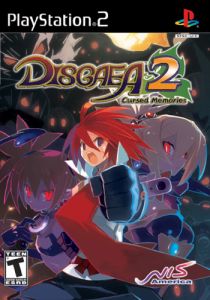
Disgaea 2: Cursed Memories is a tactical role-playing game developed and published by Nippon Ichi Software for the PlayStation 2 video game console. Disgaea 2 is the sequel to 2003's Disgaea: Hour of Darkness and was released for the PlayStation 2. It is also the predecessor to Disgaea 3: Absence of Justice for the PlayStation 3.

Mega Man Powered Up is a side-scrolling platform video game developed and published by Capcom. It was released for the PlayStation Portable (PSP) handheld game console in March 2006. It is a remake of the original Mega Man game released in 1987 for the Nintendo Entertainment System (NES). Players control the eponymous star Mega Man who must stop Dr. Wily from conquering the world using eight robots called Robot Masters. Unlike the original game, players can control these eight Robot Masters under the right circumstances. Other new features include a level creator mode and a challenge mode.
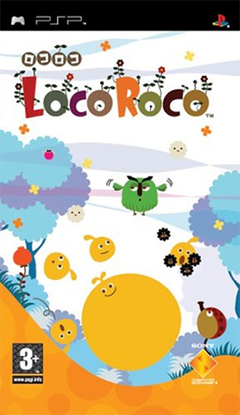
LocoRoco is a platform video game developed by Japan Studio and published by Sony Computer Entertainment, which was released worldwide in 2006 for the PlayStation Portable (PSP) handheld game console. The game was developed by Tsutomu Kouno, striving to create a game that was different from other titles being released for the PSP at the time. After demonstrating a prototype of the core gameplay to his management, Kouno was able to complete development over the course of a year and a half. In LocoRoco, the player must tilt the environment by using the shoulder buttons on the PSP in order to maneuver the LocoRoco, multi-colored jelly-like characters, through each level, being aided by other odd residents while avoiding hazards and the deadly Moja Troop, to reach an end goal.

Final Fantasy Type-0 is an action role-playing game developed and published by Square Enix for the PlayStation Portable (PSP). Released in Japan on October 27, 2011, Type-0 is part of the Fabula Nova Crystallis subseries, a set of games sharing a common mythos which includes Final Fantasy XIII and XV. The gameplay, similar to Crisis Core: Final Fantasy VII, has the player taking control of characters in real-time combat during missions across Orience. The player also engages in large-scale strategy-based battles on the world map, and has access to a multiplayer option during story missions and side quests.
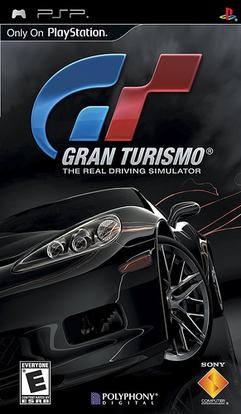
Gran Turismo is a 2009 racing video game developed by Polyphony Digital and published by Sony Computer Entertainment for the PlayStation Portable. The game was announced at Sony's E3 press conference on May 11, 2004, alongside the original PSP. Following five years of delays and speculation, during which it was variously known as Gran Turismo Portable, Gran Turismo 4 Mobile, Gran Turismo 5 Mobile and Gran Turismo 4.5, it made a reappearance at E3 on June 2, 2009, in playable form. It was released on October 1, 2009, as one of the launch titles for the new PSP Go. As of September 2017, Gran Turismo has sold 4.67 million units, making it one of the best-selling PSP games. On June 1, 2010, the game was re-released as part of Sony's Greatest Hits budget line of video games.
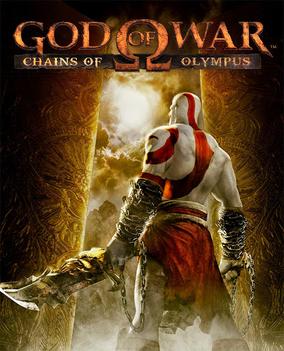
God of War: Chains of Olympus is an action-adventure hack and slash video game developed by Ready at Dawn, and published by Sony Computer Entertainment (SCE). It was first released for the PlayStation Portable (PSP) handheld console on March 4, 2008. The game is the fourth installment in the God of War series, the second chronologically, and a prequel to the original God of War. It is loosely based on Greek mythology and set in ancient Greece, with vengeance as its central motif. The player controls Kratos, a Spartan warrior who serves the Olympian gods. Kratos is guided by the goddess Athena, who instructs him to find the Sun God Helios, as the Dream God Morpheus has caused many of the gods to slumber in Helios' absence. With the power of the Sun and the aid of the Titan Atlas, Morpheus and the Queen of the Underworld Persephone intend to destroy the Pillar of the World and in turn Olympus.

Dissidia Final Fantasy is a fighting game with action role-playing elements developed and published by Square Enix for the PlayStation Portable as part of the campaign for the Final Fantasy series' 20th anniversary. It was released in Japan on December 18, 2008, in North America on August 25, 2009, and in Australia and Europe in September. It was then re-released in Japan, based on the North American version, as Dissidia Final Fantasy: Universal Tuning, on November 1, 2009.

Crush is a 2007 puzzle-platform game developed by Kuju Entertainment's Zoë Mode studio and published by Sega for the PlayStation Portable. Its protagonist is Danny, a young man suffering from insomnia, who uses an experimental device to explore his mind and discover the cause of his sleeplessness. Each level of the game, representing events from Danny's life and inspired by artists such as Tim Burton and M.C. Escher, requires the player to control Danny as he collects his "lost marbles" and other thoughts.

Space Invaders Extreme is a re-vamped incarnation of the classic arcade game Space Invaders. The DS and PSP versions were released to mark the 30th anniversary of Space Invaders which saw its original arcade release in 1978. An HD version of the game has been remastered by Backbone Entertainment for Xbox Live Arcade with new four-player multiplayer modes and visualizer backgrounds by Jeff Minter, it was released on 6 May 2009 as a wrap-up to the 30th anniversary. The game is played at a fast pace with an electronic soundtrack and sound effects.
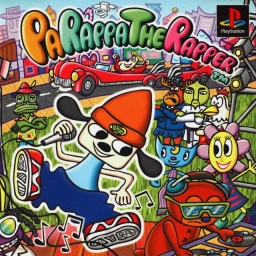
PaRappa the Rapper is a rhythm video game developed by NanaOn-Sha and published by Sony Computer Entertainment for the PlayStation in Japan in 1996 and worldwide in 1997. Created by music producer Masaya Matsuura in collaboration with artist Rodney Greenblat, the game features unique visual design and rap-based gameplay and is considered the first true rhythm game. It was ported to the PlayStation Portable in 2006 in celebration of its 10-year anniversary. A remastered version of the original PlayStation game was released for PlayStation 4 in 2017 for the game's twentieth anniversary.

Class of Heroes is a role-playing video game dungeon crawler for the PlayStation Portable developed by Zero Div and published by Acquire in Japan and Atlus in North America. In Japan, the game was released on August 26, 2008; in North America, the game was released on June 9, 2009 by Atlus. In the game, players progress by navigating dungeons as hordes of enemies appear and attack in turn-based combat. Class of Heroes received mixed reviews from critics, with some appreciating the creative take on dungeon-crawling and others disliking the game's graphics and grind-based leveling system.

Fate/unlimited codes is a fighting game planned by Cavia, developed by Eighting, and published by Capcom. It was released in Japan for arcades on June 11, 2008, and for the PlayStation 2 on December 18, 2008. An enhanced port was released for the PlayStation Portable in Japan on June 18, 2009, and was subsequently released digitally on the PlayStation Store in North America and Europe on September 3 and 10, 2009, respectively.
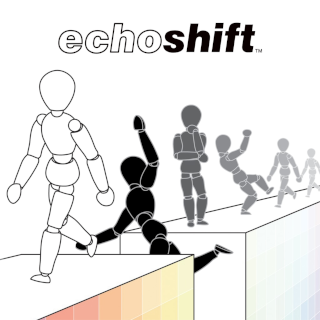
Echoshift is a 2009 puzzle video game for the PlayStation Portable and PlayStation Vita. The game uses events known as "Time Bounces" in which a small section of time repeats itself over and over again. By exploiting time bounces, the player can overcome various obstacles that would have been otherwise impossible to navigate. The game is a spinoff of the Echochrome series.
Echochrome II is a 2010 puzzle action game developed by Japan Studio and published by Sony Computer Entertainment for the PlayStation 3 utilizing the PlayStation Move. The game is the sequel to the 2008 video game, Echochrome, and was released on December 21, 2010. The game's soundtrack holds the record for the longest piece of music ever composed for a video game, at one hour, fifteen minutes, and seven seconds.
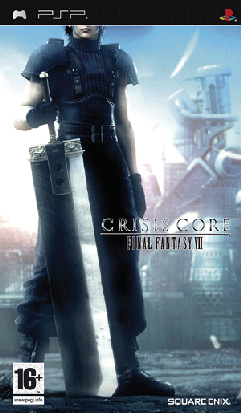
Crisis Core: Final Fantasy VII is an action role-playing game developed and published by Square Enix for the PlayStation Portable. The game was first released in 2007, and serves as a prequel to the 1997 video game Final Fantasy VII. It is part of the metaseries Compilation of Final Fantasy VII, which includes other products related to the original game.
Valkyrie Profile or Valkyrie is a series of role-playing video games created by Masaki Norimoto and Yoshiharu Gotanda, primarily developed by tri-Ace and published by Square Enix. The series is notable for featuring elements from Norse mythology.


















